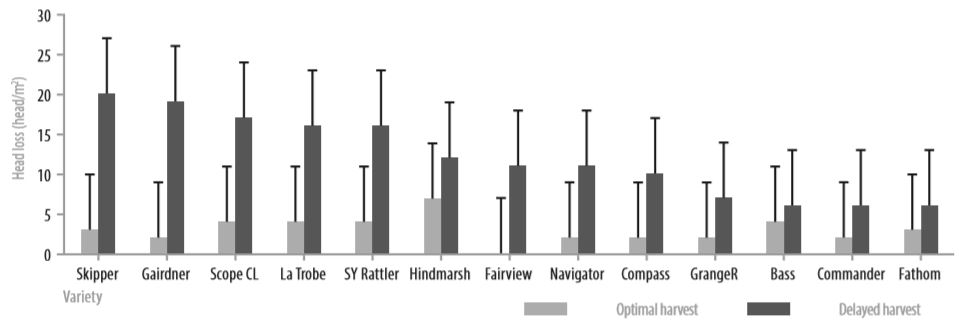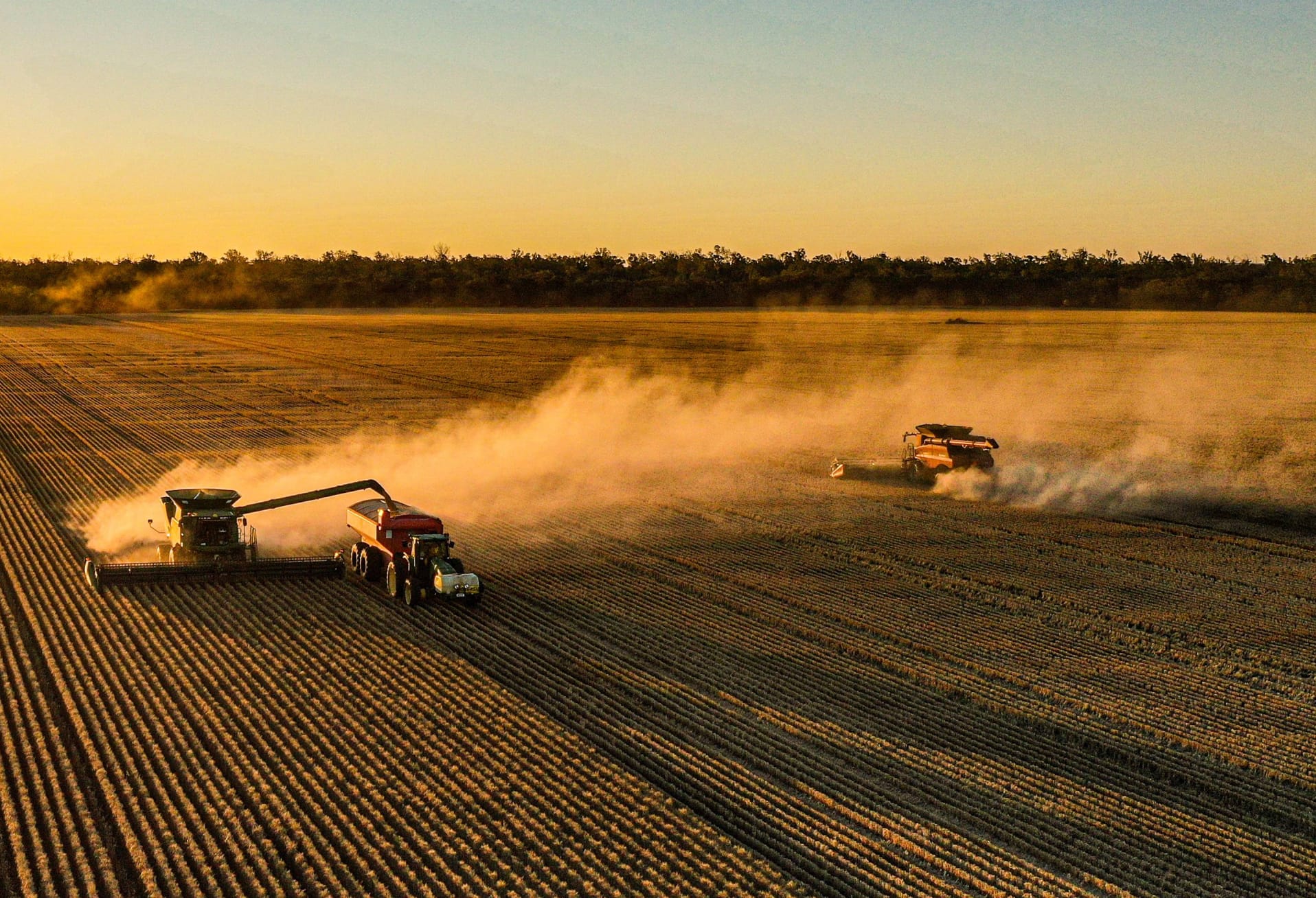TAKE HOME MESSAGES
- Delaying harvest decreased barley yields by 0.3t/ha.
- Scope CL and Gairdner harvest should be prioritised in the Mallee due to high susceptibility to head loss and yield loss.
- It is more profitable to grow higher yielding varieties and minimising their risks to delayed harvest, than to grow lower yielding varieties that have less susceptibility to delayed harvest.
BACKGROUND
Yield penalties and grain quality downgrades due to weather damage can result in loss of income to farmers growing malt and feed barley varieties. Unfavourable weather conditions at harvest time, that cause harvest to be delayed, pose a risk with yield and quality loss a potential consequence. Previous research funded by GRDC ( Gardner et al. 2012 ) found yield loss (up to 2.2t/ha in a very wet finish) and reductions in grain quality can occur when harvest is delayed. Losses are generally more significant after rainfall events.
Some barley varieties are more susceptible to head loss, lodging, sprouting and brackling (buckling in the lower part of stem). By determining which varieties are more severely affected by delaying harvest, growers may be able to make more informed choices when setting priorities at harvest time. Such information can also help growers decide which barley varieties they sow (chosen in terms of maturity, head loss and lodging rating) to spread risk in the event of a wet finish.
AIM
To compare the performance of new and current barley varieties at two different harvest times and to determine if delaying harvest compromises yield and grain quality.
METHOD
Location: Watchupga East
Replicates: Four
Treatments: Two (optimum harvest and delayed harvest)
Sowing date: 2 May
Target plant density: 130 plants/m²
Barley varieties: Gairdner, Hindmarsh, GrangeR, Bass, Commander, SY Rattler, Scope CL, Fathom, Fairview, La Trobe, Navigator, Skipper and Compass
Fertiliser: At sowing Granulock Supreme Z (50kg/ha) (treated with flutriafol 400ml/ha) 2 July Liquid Zinc (2L/ha) 9 July Urea (90kg/ha)
Herbicide: 2 May TriflurX (2L/ha) + Avadex® Xtra (2L/ha) + Weedmaster DUO® (2L/ha) + Hasten (1%) 9 July Velocity® (670ml/ha) + Lontrel™ Advanced (50ml/ha) + Hasten (1%) Fungicide: 29 August Prosaro® (150ml/ha) + Spreadwet 1000 (0.25%)
Insecticide: 23 September Alpha Duo (200ml/ha)
Seeding equipment: BCG Gason parallelogram cone seeder (knife points, press wheels, 30cm row spacing)
Harvest dates: 6 November (optimum harvest time) 17 December (delayed harvest)
The trial included two harvest dates: optimum harvest (6 November) and delayed harvest (17 December) using 13 varieties (for a summary of the barley variety agronomic characteristics used in this trial, refer to pp. 49). The delayed treatment was harvested 41 days after the first, and the site received 22mm of rain during this period (in several small events – Figure 1). Plots were assessed for lodging, brackling, head loss and stem and head counts at fortnightly intervals from the optimum harvest time until the delayed harvest. One count per plot was taken from both sides of a 50cm ruler at a fixed pin marker. Secondary head loss counts were also taken using a 50cm quadrat with the number of heads on the ground following harvest recorded.
RESULTS AND INTERPRETATION
How did the weather at harvest compare to previous years? In comparison to recent years, the 2013 harvest period was dry: rainfall did not have as big of an effect on reductions in yield and grain quality, as growers experienced in 2010 (Figure 1). There was one period where the cumulative rainfall exceeded 20mm which occurred in the first week of December over five days. A total of 22mm fell between the two harvest dates. It is believed that reductions in yield and grain quality may have been more influenced by the amount of time the crop was left standing in the paddock, than the rain. Hot weather conditions and extreme wind may have also contributed to deterioration and head loss, however this was not measured.
Figure 1. Cumulative rainfall (mm) from 1st November – 31st December (2009-2013) for Birchip.
Was there an effect of delaying harvest?
As expected, the effect of delaying harvest resulted in a greater amount of head loss (Table 2). There was a yield penalty of 0.3t/ha (mean of all varieties) when delaying harvest. Retention increased at the later harvest date, meaning grain size was larger. This could also have contributed to a lower protein (as grain size increases, protein can be diluted). However, despite the grain size potentially being larger, the test weight was lower when harvest was delayed. This may have been caused from rewetting of the grain. During the 41 days between treatments, there was rainfall on nine different occasions. Precipitation causes the grain to swell. When it fails to return to its original size, the result is the creation of bigger grains which weigh less. In addition, wet grain can stimulate the germination process which can cause starch to be digested (leaving small voids in the grain) resulting in a lower weight, ( C.O.R.N newsletter ) However, rainfall in this experiment was probably insufficient to stimulate germination. Test weight was still within malt specifications (above 65kg/hL), however, in a wetter year, a reduction in test weight may be greater, potentially compromising crops reaching malting parameters. There were no significant difference in screenings (<7%).
Table 1. Head loss, grain yield and quality for both harvest dates (mean of all varieties).
When looking at the best performing varieties (mean optimum and delayed yields), Compass, Fathom and La Trobe and Hindmarsh were the highest yielding (Figure 2).
Figure 2. Top yielding varieties (t/ha) when comparing variety only (mean of optimum and delayed yields). (Significant difference: Variety P<.001 LSD=0.25 CV8.4%).
Was there a greater effect of delaying harvest in some varieties?
Differences between varieties were observed in head loss, lodging and yield. Figure 3 shows the different percentages of yield loss (expressed as a percentage of optimum yield), for each of the varieties when harvest was delayed. Gairdner (14%) and Fathom (13%) suffered the greatest yield loss, while Hindmarsh (5%) and La Trobe (1%) had the least. This indicates that some varieties should be prioritised at harvest time, as they will incur a significant yield loss if harvesting is delayed. In saying that, when looking at yield (t/ha), it would still be more profitable to grow Fathom (mean yield 3.3t/ha) over Bass (mean yield 2.9 t/ha), despite Fathom suffering a greater percentage of yield loss (Figure 2).
Figure 3. Grain yield loss % (expressed as a percentage of optimal harvest time) at Watchupga East. (Significant difference, variety: P=0.029, LSD=7.1, CV7.7%)
In terms of grain quality, varieties all behaved similarly. Delaying harvest did not significantly impact the quality (grain protein, retention, test weight and screenings) of any one variety over the others. Protein across the site was less than 9% which is below the minimum malt level. As there was no effect of delaying harvest on the quality grade of varieties, profitability was only affected by variety and yield loss from delaying harvest. If protein levels were higher (either through higher soil nitrogen (N) or through greater N applications) the reduction in test weight may have a greater influence on the grade achieved, and therefore, profitability.
In terms of head loss, there was a significant interaction between variety and harvest date (Figure 4). At the optimum harvest time, head loss numbers were low, averaging three heads/m2, and differences among varieties were small. When harvest was delayed, Skipper, Gairdner and Scope CL lost more heads than GrangeR , Bass, Commander and Fathom. These results reflect the published variety characteristics (pp. 47).
Lodging assessments (per cent of whole plots) were completed at three different times and variety susceptibility was found to be in accordance with the variety characteristic ratings (pp. 49). Scope CL and Skipper had lodged badly by the second harvest date (up to 80-90%), while Bass, Navigator, Gairdner and GrangeR stood up extremely well (less than 10% lodging). The combination of high head loss and lodging in Scope CL and Skipper was probably influenced more by the delay in harvest time than by rainfall damage, given the small rainfall events experienced. As these varieties were most affected by head loss and lodging, combined with a reduction in yield (%), growers should consider harvesting these varieties first to minimise losses.
Figure 4. Number of heads (heads/m2) lost (after harvest) when delaying harvest. (Significant difference, variety head loss x harvest: P=<0.001, LSD=7, CV64.5%).
In a wetter finish, grain discoloration and sprouting may be an issue for susceptible varieties, but this was not a problem in 2013. Interactions between stem height and head retention ratings were also analysed but the differences between varieties were not statistically significant.
COMMERCIAL PRACTICE
In 2013, delaying harvest incurred a yield penalty of 0.3t/ha (mean of all varieties) and reduced grain quality, in a relatively dry year. Some varieties were penalised in terms of yield loss, head loss and lodging when delaying harvest.
Scope CL and Gairdner are commonly grown varieties in the Mallee. Due to a higher yield and head losses in Scope CL and Gairdner (and lodging in Scope CL), these varieties should be prioritised at harvest to reduce risks associated with delaying harvest. Best yielding varieties (mean of both harvest yields) were Compass, Fathom, La Trobe and Hindmarsh.
Given the unpredictability of seasons, a good risk management strategy to adopt is to opt for a high yielding variety that is well adapted to a wide harvesting window. Also consider variety ratings for standing ability/lodging, maturity height and head retention (available from the 2013 GRDC Victorian Winter Crop Summary). In this trial, the varieties that did incur higher head loss and lodging (contributing to yield loss) were in general agreement with this guide. In the case of a much wetter harvest, past research has proven that delaying harvest results in even greater yield losses and quality damage, than identified in this trial.
REFERENCES
Crop observation and recommendation network, Laura Lindsey, (2013) Late-season Rainfall, Late Harvest and Wheat Grain Quality, 13 December 2013
Department of Agriculture and food WA, (2013), Barley variety technical guide for WA 2014
Gardner M, McMullen G, (2012) ‘The yield and quality penalty of a wet harvest-barley’, (Northern Grains Region Trial Results Autumn 2012)
GRDC, Victorian winter crop summary 2013.
South Australian research and development institution, (2013), Barley Variety sowing guide 2014, 20 December 2013
ACKNOWLEDGMENTS
The trial was funded by the GRDC’s ‘Barley Agronomy for the Southern Region’ project (project code: DAN00173).





